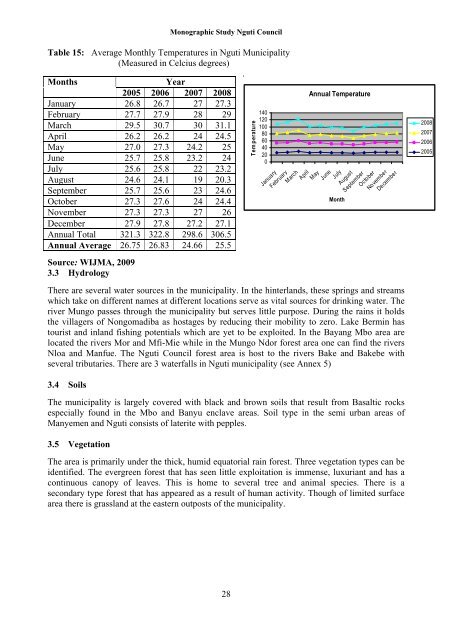nguti council monographic study - Impact monitoring of Forest ...
nguti council monographic study - Impact monitoring of Forest ...
nguti council monographic study - Impact monitoring of Forest ...
- No tags were found...
You also want an ePaper? Increase the reach of your titles
YUMPU automatically turns print PDFs into web optimized ePapers that Google loves.
Monographic Study Nguti CouncilTable 15: Average Monthly Temperatures in Nguti Municipality(Measured in Celcius degrees).MonthsSource: WIJMA, 20093.3 HydrologyYear2005 2006 2007 2008January 26.8 26.7 27 27.3February 27.7 27.9 28 29March 29.5 30.7 30 31.1April 26.2 26.2 24 24.5May 27.0 27.3 24.2 25June 25.7 25.8 23.2 24July 25.6 25.8 22 23.2August 24.6 24.1 19 20.3September 25.7 25.6 23 24.6October 27.3 27.6 24 24.4November 27.3 27.3 27 26December 27.9 27.8 27.2 27.1Annual Total 321.3 322.8 298.6 306.5Annual Average 26.75 26.83 24.66 25.5Temperature140120100806040200JanuaryFebruaryMarchAnnual TemperatureAprilMayJuneJulyMonthAugustSeptemberOctoberNovemberDecember2008200720062005There are several water sources in the municipality. In the hinterlands, these springs and streamswhich take on different names at different locations serve as vital sources for drinking water. Theriver Mungo passes through the municipality but serves little purpose. During the rains it holdsthe villagers <strong>of</strong> Nongomadiba as hostages by reducing their mobility to zero. Lake Bermin hastourist and inland fishing potentials which are yet to be exploited. In the Bayang Mbo area arelocated the rivers Mor and Mfi-Mie while in the Mungo Ndor forest area one can find the riversNloa and Manfue. The Nguti Council forest area is host to the rivers Bake and Bakebe withseveral tributaries. There are 3 waterfalls in Nguti municipality (see Annex 5)3.4 SoilsThe municipality is largely covered with black and brown soils that result from Basaltic rocksespecially found in the Mbo and Banyu enclave areas. Soil type in the semi urban areas <strong>of</strong>Manyemen and Nguti consists <strong>of</strong> laterite with pepples.3.5 VegetationThe area is primarily under the thick, humid equatorial rain forest. Three vegetation types can beidentified. The evergreen forest that has seen little exploitation is immense, luxuriant and has acontinuous canopy <strong>of</strong> leaves. This is home to several tree and animal species. There is asecondary type forest that has appeared as a result <strong>of</strong> human activity. Though <strong>of</strong> limited surfacearea there is grassland at the eastern outposts <strong>of</strong> the municipality.28

















